Content
Red currant Dar Orla is a variety that many gardeners were able to appreciate. Its feature is a stable yield while observing simple rules of agricultural technology. The fruits of this currant are distinguished by a high content of vitamins and minerals, therefore they are used in cooking, as well as for medicinal purposes. But in order for this shrub to fully develop, it is necessary to provide it with favorable conditions, taking into account its characteristics.
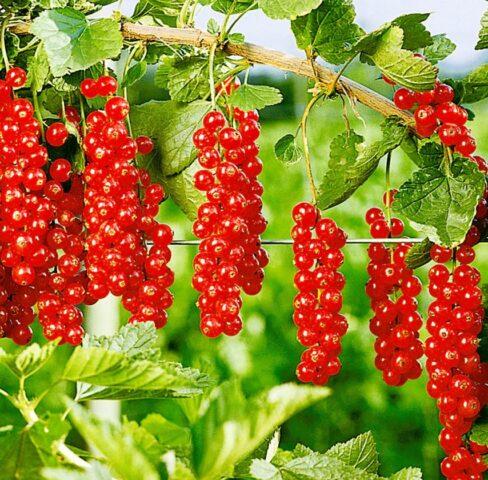
Red currant Gift of the Eagle is distinguished by its versatility
Breeding history
This species was obtained at the All-Russian Research Institute of Selection of Fruit Crops of the Oryol Region. The application for admission to testing was made in 2000, and only 18 years later it received permission to use.
The authors of the variety are employees of the institute, namely L.D.Bayanova and O.D. Golyaeva. The purpose of the creation was to obtain a type of red currant, which will be distinguished by high yield, increased resistance to adverse weather conditions, as well as common crop diseases. And the creators completely succeeded. The varieties Rote Spätlese and Jonker van Tete became the basis for it. Gift of the Eagle is recommended for cultivation in the West Siberian region.
Description of the currant variety Dar Eagle
This culture variety is characterized by vigorous medium-spreading bushes, the height of which reaches 1.5 m, and the growth diameter is 1.2 m. The shoots of this species of red currant are thickened in diameter about 1 cm, with a weak edge on the surface. The shade of the bark changes with the age of the branches. Initially, it is deep green, and later becomes gray-brown.
The buds of the Dar Orla red currant are medium in size, have an ovoid shape, and are also slightly pubescent. The leaves are large, five-lobed, dark green in color. The surface of the plates is matte, slightly concave. The central segment is longer than the lateral ones; a right angle is formed at the joints of the leaf parts. The teeth are blunt, short, not bent. There is a small rounded notch at the base of the leaves. Petioles are thickened, medium-sized with anthocyanin, without edges.
The flowers of this red currant are medium in size, light. Sepals are twisted, not closed. Fruit clusters up to 16 cm long, dense, directed downward. Each of them can form up to 26 berries. The axis of the fruit brushes is pubescent, straight, thickened.
The berries of this type of red currant are round in shape, when ripe they acquire a red color. The average weight of each is 0.5-, 07 g. Their skin is thin, dense, slightly felt when eaten. The pulp is fleshy, juicy, contains a moderate amount of seeds. The taste of ripe berries is sweet and sour. The tasting score of the Dar Orla red currant is 4.3 points out of a possible five.
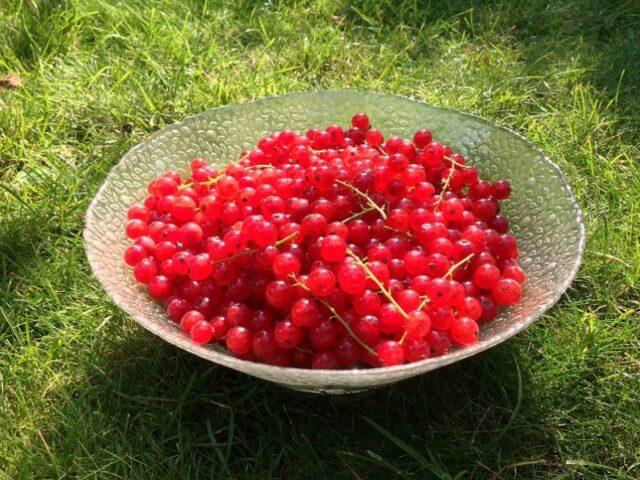
Berries have good gelling properties
The harvest is suitable for fresh consumption, as well as for making jam, jam, compotes, filling for desserts.
Characteristics
Red currant Dar Orla surpasses many types of culture in its characteristics. And to be sure of this, you need to familiarize yourself with them.
Drought tolerance, winter hardiness
The shrub is highly resistant to frost.He does not suffer from a drop in temperature down to -50 ° C. Also, this red currant is immune to spring return frosts, since the period of its flowering begins when the threat of their appearance passes.
Gift of the Eagle can easily endure short dry periods. But a long-term lack of moisture in the soil can provoke crushing of the fruits.
Pollination, flowering period and ripening times
The species is classified as late. It blooms at the end of May. This period lasts for him about ten days. The harvest ripens at the end of July. At the same time, the berries are colored in the brush at the same time. A ripe crop lasts up to a month on the branches.
This variety is self-fertile and does not need pollinators to set the ovary. This level is 58-74%. Therefore, the red currant Dar Orla shows a high and stable yield annually.
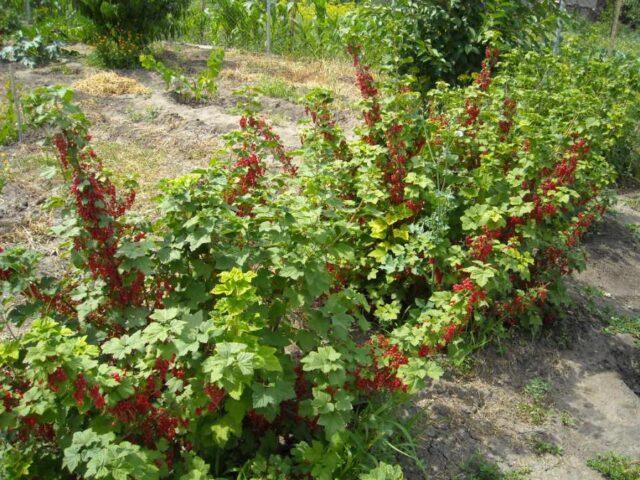
Red currant Gift of the Eagle is resistant to shedding
Productivity and fruiting
The bush begins to bear fruit from the second year after planting. He shows maximum performance in the sixth year. And after that, his productivity decreases. Therefore, it is recommended to remove old branches in a timely manner, replacing them with young ones.
The yield of the red currant Gift of the Eagle is 10 kg from one bush. Fruits at the stage of technical maturity easily tolerate transportation in the first 2-3 days after harvest, provided they are packed in containers of 3 kg. You can keep the harvest fresh in a cool room for up to five days.
Disease and pest resistance
The Gift of the Eagle is characterized by strong natural immunity. This shrub is not susceptible to powdery mildew, kidney mites. Under unfavorable growing conditions, it can be slightly affected by septoria and moderately by anthracnose.
Therefore, experienced gardeners recommend to maintain the immunity of the shrub at a high level in early spring and after harvesting in the fall to carry out preventive treatment with preparations containing copper ions. From pests should be used "Neoron", "Fufanon", "Bayleton".
Advantages and disadvantages
Red currant Gift of the Eagle has certain advantages that make it stand out from the rest. But the shrub also has weaknesses that need to be paid attention to.
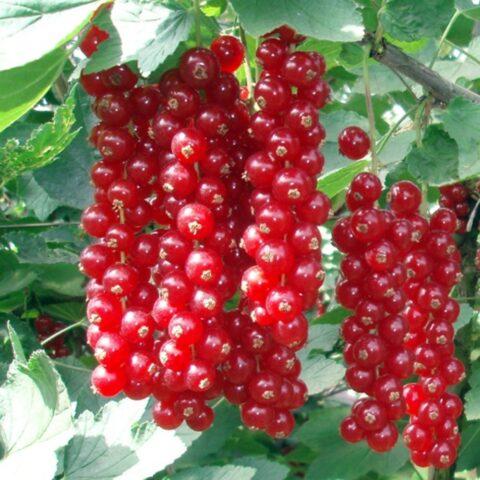
Berries of the Dar Orla variety are suitable for freezing
Main advantages:
- high, stable yield;
- frost resistance;
- strong natural immunity;
- immunity to temperature extremes;
- marketability;
- versatility of application;
- possibility of transportation;
- dry separation of berries.
Disadvantages:
- does not tolerate stagnant moisture in the soil;
- suffers from dry air;
- needs regular crown renewal.
Features of planting and care
It is necessary to plant bushes of this red currant in open sunny areas. Placing a shrub in the shade stimulates the active growth of shoots, to the detriment of the formation of fruits. The Dar Orla variety prefers to grow in loamy and sandy loam soil with low acidity and good aeration. In this case, the occurrence of groundwater at the site must be at least 0.6 m.
Planting of bushes should be carried out in early spring before the beginning of the growing season or late in the fall after its end. It is necessary to place seedlings at a distance of 1.2 m, taking into account their growth diameter. When planting, deepen the root collar by 3-4 cm, which activates the growth of lateral shoots.
In the future, caring for the plant does not require complex actions. Watering the red currant Gift of the Eagle is necessary only during long dry periods. To do this, use settled water at the rate of 10 liters for each bush. Throughout the season, loosen the soil at the base of the plants and remove weeds. This will maintain air access to the roots.
You need to fertilize the Gift of the Eagle three times per season. The first time organic matter should be applied in the spring before the start of the growing season. The second is to feed with nitroammophos during the blooming period. And the third time it is necessary to fertilize the shrub during the formation of the ovaries, using phosphorus-potassium mineral mixtures.
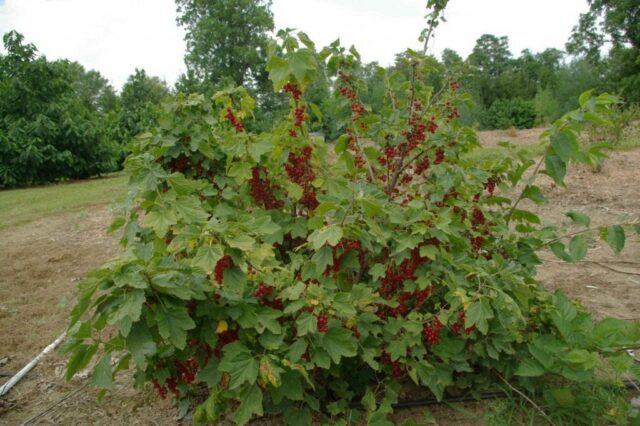
The life span of a shrub in one place is 30 years.
Caring for fruit shrubs involves annual cleaning of the crown in the spring from broken and damaged shoots, as well as old branches.
Conclusion
Red currant Dar Orla is a highly productive crop variety that is capable of producing a stable harvest with minimal maintenance. This plant is highly resistant to diseases and pests. These qualities have contributed to its growing popularity among both beginner and experienced gardeners.
Reviews about the currant Gift of the Eagle








